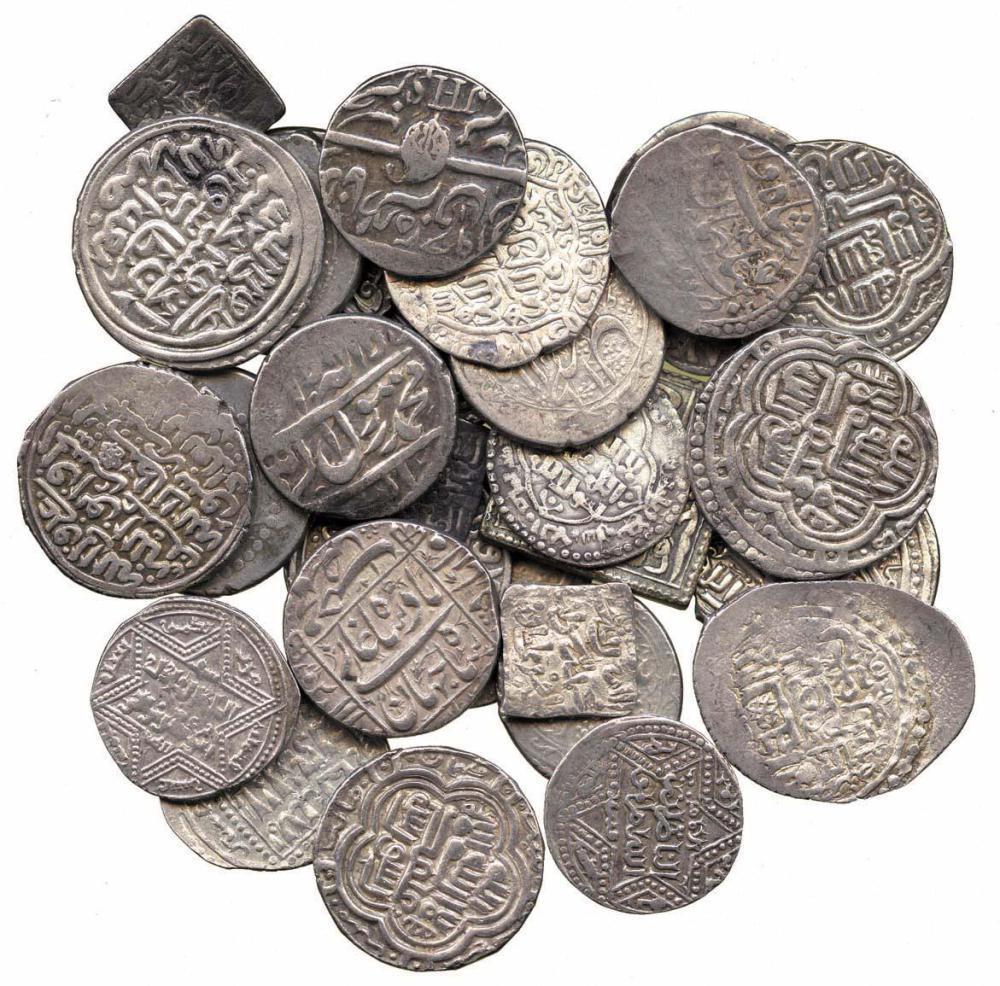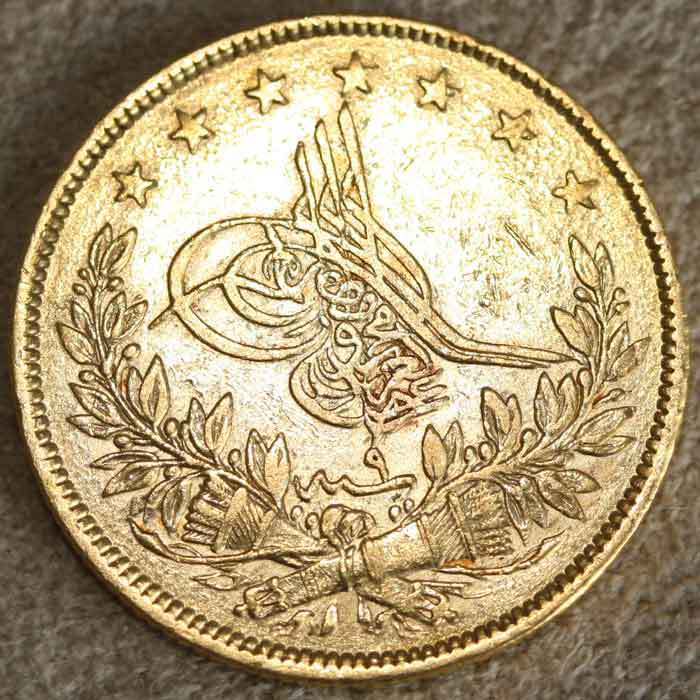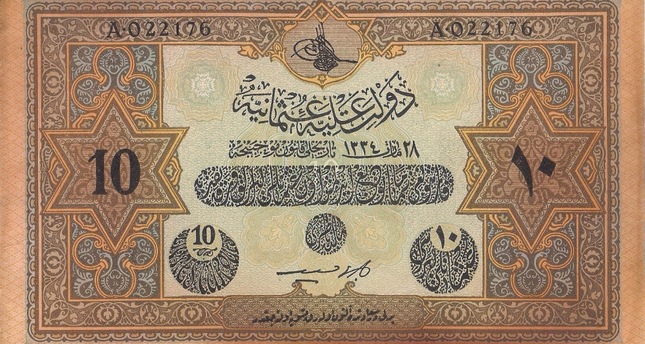.jpg)
A MONETARY HISTORY OF ISLAMIC SOCIETIES
The use of money dates back thousands of years. As in other cultures, minting of coins and banknotes was a reflection of a ruler's power in Islamic societies, although their shapes and names have changed over and over again
 Islamic silver coins from the Abbasid and Ayyubid caliphate
Islamic silver coins from the Abbasid and Ayyubid caliphate
Before the arrival of Islam, Arab, Persian and Roman gold and silver coins were used in Mecca and Prophet Muhammad used these coins as well. Caliph Umar was the first ruler that issued coins in Islamic history. In 640 A.D., 18 years after the Hegira, Umar issued short, thick coins in the shape of kernels, weighing 3.36 grams and reminiscent of Persian coins. Caliph Uthman issued gold and silver coins in 650 B.C. The first round silver coin was issued by Caliph Abd Allah ibn al-Zubayr (680-692) in Mecca. Most of the Islamic states issued coins. Gold and silver coins issued with a certain weight are called "sikke."
Although Seljuk coins were used in the early Ottoman period, Sultan Osman I, the founder of the Ottoman Empire, issued the first Ottoman silver coin called "akche." These akches weighed 0.68 grams at first, but they later varied in weight. In the 17th century the amount of silver used in akches was reduced one-sixth. The very first Ottoman golden coin was issued by Mehmed the Conqueror in 1478. Later on, various coins were issued and several laws were introduced to standardize coin minting.
During the reign of Sultan Murad I, copper coins called "mangır" or "fülüs" were issued to facilitate purchasing less valuable products. The amount difference between the coins' expense and their written value were recorded in the treasury. The practice of printing the date on coins started with Sultan Bayezid I and printing the sultan's signature, or "tughra," on coins became regular practice Sultan Mehmed I. Apart from Ottoman coins, Venetian, Polish, Dutch, German, French, Egyptian and Persian coins also circulated in the Ottoman Empire. Since the arrival of money, gold and silver have been considered currency in every community whether the coins bore the portrait of Napoleon Bonaparte or an Ottoman sultan.
 Ottoman coin
Ottoman coin
The silver in coin
Akche, the silver coin, was the official currency of the Ottoman Empire. The gold coin was considered big money while mangır was on the other end of the spectrum. After 1687, "kurush" were announced as the official Ottoman currency.
Three mangırs (aka "pul") were equal to one akçe, three akches were equal to one "para," 40 paras were equal to one silver kurush and 100 kurush were equal to 1 Ottoman gold coin.
Whenever a new sultan succeeded to the throne, he prohibited the use of the coins issued by his predecessor and introduced new ones. The public took the old coins to the state mint and they were melted and minted into new coins for a small fee. As the treasury was drained with wars, the amount of silver in akche was reduced, but this caused dissatisfaction among the public. During the reign of Sultan Abdülmecid, the akche was withdrawn from circulation and instead silver coins called "majidiya," which weighed 24 grams, were issued. An Ottoman gold coin of 7.2 grams was equal to five majidiyas, one majidiya was equal to 20 silver kurush and 1 kurush was equal to 40 paras.
There were state mints in the important cities of the Ottoman Empire. Coins were not only issued by the state, though, as those who wanted to mint their own money could take their silver and gold and mint coins for a fee. Mints were tendered for a contract for three years to individuals for managing. If nobody showed up for the tender, a paid state official was trusted with the management of the mint. Although the government could track the amount of coins that were issued under the supervision of a state official, it was much less profitable.

Banknotes
Banknotes called "jiaozi" have been used in China since the 10th century. These banknotes were rectangular pieces of cardboard featuring the emperor's seal. Although the fifth Mongol Ilkhanate ruler Gaykhatu printed banknotes in 1295 and ordered his subjects to use them instead of silver and gold coins, they did not use these banknotes. Izz al-Din Muzaffar, Sultan of Azerbaijan, attempted to print banknotes, but the public did not accept it and even killed the sultan in a rebellion. Gold and silver are considered to be currency until doomsday in Islamic law. Although it is lawful to use copper and nickel mangırs and banknotes, gold and silver backs the money.
In the Ottoman Empire, the first banknote, called "qaima," was circulated in 1850. One lira in qaima was equal to one Ottoman gold coin (100 kurush). However, the public did not show interest in the new banknote and it rapidly lost its value against gold coins. The banknote was withdrawn from circulation in 1862. During the 1877 Russo-Turkish War, it was recirculated but was entirely withdrawn after it lost a great amount of value against gold. In 1915, at last, another banknote "Awraq-i Naqdiyya" was issued and banknotes are still in use.
Because Ottoman coins were to gold and silver, a common phrase emerged. When describing something not precious, people used to say: "It does not value 10 liras in infidel currency." Islamic states preferred to use coins. Compared to banknotes, coins are much healthier and cleaner. In the early years of the Republic of Turkey, many tradesmen in Anatolia still used gold and silver coins in trade instead of banknotes.
Glass coins
For a while, glass coins called "Sanjat-ı Zuiajiya" were issued in the Islamic Middle East. During the period of Umayyad, Abbasid and Fatimid Caliphates, glass coins were issued with the name of certain caliphs or, most often, governors. Many examples of glass coins are kept in museum collections in France and the U.K. as collectors and numismatists still show a great interest in them. A British museum catalogue published in 1891 features around 400 of them.
Önceki Yazılar
-
"WOE TO THE ENEMIES OF THE REVOLUTION!" What Was The People’s Reaction To The Kemalist Revolutions?2.07.2025
-
DEATH IS CERTAIN, INHERITANCE IS LAWFUL!25.06.2025
-
THE SECRET OF THE OTTOMAN COAT OF ARMS18.06.2025
-
OMAR KHAYYAM: A POET OF WINE OR THE PRIDE OF SCIENCE?11.06.2025
-
CRYPTO JEWS IN TURKEY4.06.2025
-
A FALSE MESSIAH IN ANATOLIA28.05.2025
-
WAS SHAH ISMAIL A TURK?21.05.2025
-
THE COMMON PASSWORD OF MUSLIMS14.05.2025
-
WERE THE OTTOMANS ILLITERATE?7.05.2025
-
OTTOMAN RULE BENEFITED THE HUNGARIANS30.04.2025